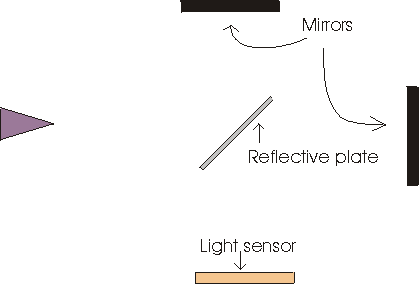
The original purpose of this experiment was to prove the existence of ether. According to that theory, light should move through the ether at different speeds, depending on your relative movement through space. The device pictured below called an interferometer was designed to detect the minute differences of a arrival time of two light beams. One of the light beams should theoretically take longer to reach the sensor because of the path it must follow through the ether.
| A light beam was shot through a partially reflective plate. Half of the light would be reflected up towards a mirror; the other half of the light beam would go straight through to the other mirror. | |
 |
The light beams would then bounce back and hit a sensor. |
| According to Newton's laws, the light should reach the sensor at slightly different times. | |
| When the light beam hits the sensor at the same time, it looks like this: | When the light hits the sensor at different times, it looks like this: |
|
|
| In the experiment, the sensor always
looked like the left target. The results showed that light did not travel at different speeds, but these results were not believed by most of the scientific community. Michelson himself felt that this experiment had failed, and he continued to believe the experiment failed for the rest of his life. However, Einstein's theory of relativity was able to account for these results. According to Einstein, there is no such thing as ether. Light has a constant speed no matter what frame of reference you are measuring it from. |
|